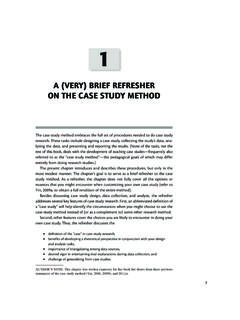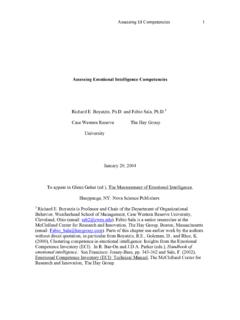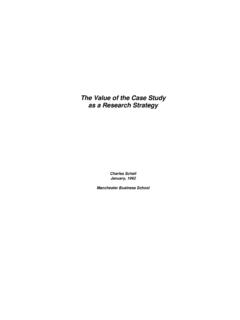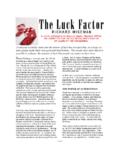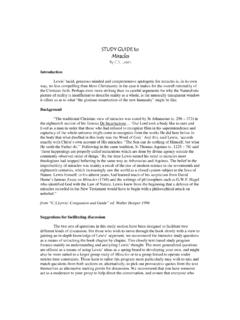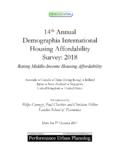Transcription of Impact of the Trump Tariff.NFAP Policy Brief.May 2016
1 N A T I O N A L F O U N D A T I O N F O R A M E R I C A N P O L I C Y N F A P P O L I C Y B R I E F M A Y 2 0 1 6 T H E T R U M P T A R I F F S : A B A D D E A L F O R A M E R I C A N S B Y D A V I D G . T U E R C K , P A U L B A C H M A N A N D F R A N K C O N T E EXECUTIVE SUMMARY Presidential candidate Donald Trump s proposed tariffs on China, Mexico and, by implication, Japan would be ineffective in shielding american workers from foreign imports, since producers from other countries would export the same products to the United States. Were such tariffs to be effective, then the tariffs would impose a regressive consumption tax of $11,100 over 5 years on the typical household. The Impact would hit poor Americans the hardest: A tariff of 45% on imports from China and Japan and 35% on Mexican imports would cost households in the lowest 10% of income up to 18% of their (mean) after-tax income or $4,670 over 5 years.
2 Table 1: Effect of Trump Tariffs on China, Mexico and Japan on Households over Five Years Item All households ($56,437 mean after-tax Income) Lowest 10 % ($5,348 mean after-tax Income) Second 10 % ($15,182 mean after-tax Income) Fifth 10% ($38,735 mean after-tax Income) Ninth 10% ($97,430 mean after-tax Income) Highest 10% ($172,669 mean after-tax Income) Tariff burden ($) $11,100 $4,670 $4,830 $8,430 $17,390 $25,005 Percentage of mean after-tax Income 4% 18% 6% 4% 4% 3% Source: Bureau of Labor Statistics, Consumer Expenditure Survey, 2015. Calculation of cost increase for imported goods. Why would the Trump tariffs be ineffective? The analysis examined 30 randomly selected cases over the past 15 years when the government imposed anti-dumping or countervailing duties on goods and found that, in the aggregate, imports of those goods rose by 25% from the year before the duty order was issued, meaning producers from countries not affected by the duties exported similar goods to the United States.
3 As a result, the duties did not protect workers or industries from foreign competition. This finding indicates that Donald Trump s proposal to impose tariffs on China, Mexico and Japan would meet a similar fate. The ineffectiveness of Trump s tariffs on China, Mexico and Japan in protecting workers from foreign competition means to achieve his goal the only logical alternative would be to impose a similar set of tariffs on all other countries that export to the United States. A Trump tariff levied on imports from all countries would cost the average household $6,112 annually and $30,560 over a five-year period. This worldwide tariff would cost households in the lowest income decile $2,826 annually or $14,130 over five years and households in the highest income decile $12,514 annually, and $62,570 over five years. N A T I O N A L F O U N D A T I O N F O R A M E R I C A N P O L I C Y P a g e The Trump Tariffs: A Bad Deal for Americans 2 We find that a Trump tariff proposal against all countries would cost consumers $459 billion annually and $ trillion over five years.
4 Our analysis finds that the Trump tariffs would manifest themselves as a increase in the price of competing domestic producer goods and, therefore, as a cut in real wages. Table 2: Effect of Trump Tariffs on All Countries on Households over Five Years Item All households ($56,437 mean after-tax Income) Lowest 10 % ($5,348 mean after-tax Income) Second 10 % ($15,182 mean after-tax Income) Fifth 10% ($38,735 mean after-tax Income) Ninth 10% ($97,430 mean after-tax Income) Highest 10% ($172,669 mean after-tax Income) Tariff burden ($) $30,560 $14,130 $15,155 $24,780 $46,285 $62,570 Percentage of mean after-tax Income 11% 53% 20% 13% 10% 7% Source: Bureau of Labor Statistics, Consumer Expenditure Survey, 2015. Calculation of cost increase for imported goods. When we calculate the burden as a percentage of household income, we find that households in the lower income deciles would surrender a higher portion of their income under a Trump tariff than higher income households.
5 A Trump tariff against all countries costs households in the lowest decile 53% of their annual income, while it would cost households in the highest decile 7% of their incomes. The tariffs would cost households in the second income decile 20% of their annual income a figure that declines as we move up the income deciles. In other words, a Trump tariff against all countries (or even one against only China, Mexico and Japan) would be a regressive tax that burdens lower income households more than higher income households. The analysis included calculations of the dead loss (net loss to the economy) of potential tariff increases using standard methodology. That included first estimating the reduction in imports from China, Mexico and Japan for 97 categories of goods under the two-digit Harmonized Tariff Schedule (HTS) and determining the Armington elasticities for each of these 2 digit HTS category codes.
6 (The Armington method is based on an assumption that the country of origin of a product distinguishes it from other countries.) The increase in the tariff rates discussed by the Trump proposal were multiplied by the Armington elasticities. This allowed a calculation of the loss to the economy for each commodity category and each of the three countries. The methodology was also used to calculate the Impact of a worldwide tariff and the effect on households at different income levels under both the three country scenario and a worldwide tariff. N A T I O N A L F O U N D A T I O N F O R A M E R I C A N P O L I C Y P a g e The Trump Tariffs: A Bad Deal for Americans 3 The estimates by income decile are conservative in that they do not take into account imports that serve as intermediate goods (goods used to produce other goods).
7 In addition, tariffs targeted against imports from China, Japan and Mexico, as well as a worldwide tariff, would be certain to bring retaliation in the form of tariffs on exports, which would carry additional economic impacts. Even without retaliation, exports to the three countries would fall by 78% as a result of business losses that the three countries would incur as imports from them declined. In total, Trump s proposed tariffs against just China, Japan and Mexico would impose a dead loss on the economy of $170 billion annually and $850 billion over five years. The economy would suffer a total annual burden in the form of a $278 billion loss in household purchasing power akin to a general new tax on after-tax income. The annual benefits to producers would be only $43 billion, or 15% of the loss experienced by consumers. If Trump decided to impose worldwide tariffs on the products exported by the three countries in order to shut down imports of those products once and for all, then the results would be truly catastrophic for the poor.
8 It would be as if the United States imposed a new tax of 53% on the lowest 10% income decile and a 20% tax on the next lowest decile. It would be equivalent to an 11% flat tax on the after-tax income of workers. The total burden on consumers would be $760 billion annually. The dead loss to the economy would be $459 billion annually. That would not seem to be a recipe to make America great again. N A T I O N A L F O U N D A T I O N F O R A M E R I C A N P O L I C Y P a g e The Trump Tariffs: A Bad Deal for Americans 4 Trump S PROPOSALS FOR PUNITIVE TARIFFS In what would be a radical departure from almost 75 years of trade poilcy, Presidential candidate Donald Trump has threatened to impose a 45% tariff on goods and services produced in China. (Campbell, 2016) He also pledges, if elected, to impose a 35% tariff on selected goods from Mexico (Groden, 2015) and, by implication, a tariff on Japan.
9 In a Republican debate in 2015, Trump declared, Our country is in serious trouble. We don't win anymore. We don't beat China in trade. We don't beat Japan, with their millions and millions of cars coming into this country, in trade. We can't beat Mexico, at the border or in trade. (On the issues, 2016) Japan has long been an obsession with Trump going back to the 1980s. In June 2015, he said, "They send their cars over by the millions, and what do we do? When was the last time you saw a Chevrolet in Tokyo? It doesn't exist, folks. They beat us all the time." (Clark, 2015) Over the course of the campaign, the candidate has repeated the claim that these three nations were the beneficiares of poorly negotiated trade policies that placed the United States at a disadvantage. His solution is to impose draconian tariffs on China, Mexico and, apparently, Japan. Should such tariffs be enacted, however, there would follow a major disruption in the international order.
10 The entire framework for multilateral trade agreements could be displaced in favor of economic nationalism and the ideas promoted by Adam Smith and David Ricardo would no longer guide trade between nations. The Trump tariffs would disrupt a process that traces back to the General Agreement on Tariffs and Trade, extends through establishment of the World Trade Organization and the laying of the groundwork for the prospective Trans-Pacific Partnership and Transatlantic Trade and Investment Partnership (Council of Economic Advisors, 2015, pp. 93, 303) now working their way through the negotiation and legislative process. Trump has dismissed arguments that his proposal would hurt consumers. (Tankersley, 2016) In his view, it won t matter if the tariffs raise consumer prices if they shore up jobs and wages in sectors that compete with imports. We show in this report, however, that the tariffs would inflict huge costs on consumers.




